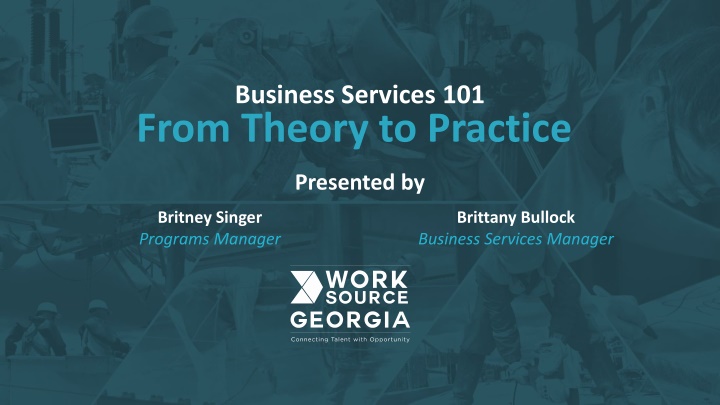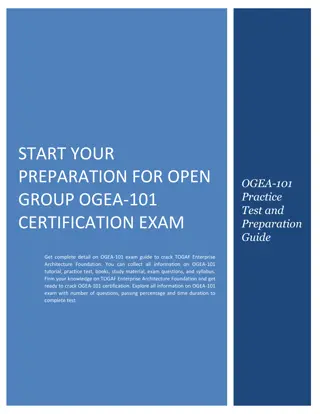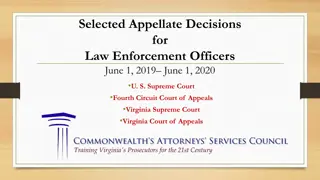
Practical Insights into Business Services Training Programs
Explore the practical aspects of on-the-job training, incumbent worker training, and customized training programs in the business services sector. Learn about requirements, benefits, and considerations for employers and participants. Presented by industry experts Britney Singer and Brittany Bullock.
Uploaded on | 0 Views
Download Presentation

Please find below an Image/Link to download the presentation.
The content on the website is provided AS IS for your information and personal use only. It may not be sold, licensed, or shared on other websites without obtaining consent from the author. If you encounter any issues during the download, it is possible that the publisher has removed the file from their server.
You are allowed to download the files provided on this website for personal or commercial use, subject to the condition that they are used lawfully. All files are the property of their respective owners.
The content on the website is provided AS IS for your information and personal use only. It may not be sold, licensed, or shared on other websites without obtaining consent from the author.
E N D
Presentation Transcript
Business Services 101 From Theory to Practice Presented by Britney Singer Programs Manager Brittany Bullock Business Services Manager
Agenda Nuts and Bolts Monitoring Resources Activity Wrap-Up & Questions
On-the-Job Training Definition Requirements Provided under a contract with an employer or registered apprenticeship program sponsor in the public, private non-profit, or private sector. Through the OJT contract, occupational training is provided for the WIOA participant in exchange for the reimbursement, typically up to 50 percent of the wage rate of the participant, for the extraordinary costs of providing the training and supervision related to the training. In limited circumstances, as provided in WIOA sec. 134(c) (h) and 680.730, the reimbursement may be up to 75 percent of the wage rate of the participant. Training by an employer that is provided to a paid participant while engaged in productive work in a job that provides knowledge or skill essential. OJT contracts under WIOA Title 1, must not be entered into with an employer who has received payments under previous contracts under WIOA or WIA if the employer has exhibited a pattern of failing to provide OJT participants with continued long- term employment as regular employees with wages and employment benefits and working conditions at the same level and to the same extent as other employees working a similar length of time and doing the same type of work. OJT contract must be limited to the period of time required for a participant to become proficient in the occupation for which the training is being provided. In determining the appropriate length of the contract, consideration should be given to the skill requirements of the occupation, the academic and occupational skill level of the participant, prior work experience, and the participant s IEP.
Incumbent Worker Training Definition Requirements The individual worker needs to be employed in a situation that meets the Fair Labor Standards Act requirements for an employer-employee relationship. Established employment history with the employer for 6 months or more with the exception that the incumbent worker training is being provided to a cohort of employees, not every employee in the cohort must have an established employment history with the employer for 6 months or more as long as the majority of those employees are being trained to meet the employment history requirement. Designed to meet the needs of an employer or group of employers to retain a skilled workforce or avert layoffs. Does not have to meet the eligibility requirements for career and training services for Adult and Dislocated Worker under WIOA, unless they are also enrolled as a participant in the WIOA Adult or Dislocated Worker program. Eligibility Determination: is determined at the Employer level and does not have to meet the eligibility requirements for Career Services and Training Services for Adult/Dislocated Worker programs under WIOA.
Customized Training Definition Requirements The employee is underemployed Designed to meet the special requirements of an employer or a group of employers by allowing them to tailor and design work-based skills training. Customized training is conducted with a commitment by the employer to employ an individual after successful completion of the training and for which the employer pays a significant portion of the cost of training. The employer, or group of employers, have made the commitment to employ or continue to employ, an individual that has successfully completed the program; and The customized training relates to the introduction of new technologies, introduction to new production or service procedures, upgrading to new jobs that require additional skills, workplace literacy, or other appropriate purposes. Ideal for programs that may not include a WIOA-accepted industry-recognized credential or training is being provided by training providers not on the state s ETPL Employees must be WIOA eligible
Training Options Individual Training Account (ITA): An ITA is an expenditure account established on behalf of an eligible participant to purchase training services from eligible providers they select in consultation with a case manager. (Ex: An ITA may be established with Atlanta Technical College for an eligible participant to study welding.) Registered Apprenticeship: A flexible training system that combines job related instruction with structured on-the-job learning experiences. Upon completion, participants receive an industry issued, nationally recognized credential that certifies occupational proficiency, is portable, and provides a pathway for economic mobility. Programs that have worked with the Department of Labor to be recognized as RA, automatically qualify to be placed on the State and local board s Eligible Training Provider List (ETPL).
Work Experience Definition Requirements Provided under an agreement amongst LWDA, employer/worksite, and participant (Adult, Dislocated Worker, or Youth). A planned, structured learning experience that takes place in a workplace for a set period of time. Designed to enable participants to explore career options, gain exposure to the working world and its requirements, and enhance the employability of individuals through the development of good work habits and basic work skills. Not designed to benefit the employer. Individuals placed in WEX are generally considered trainees and should not take on roles in which the employer depends on the trainee s productivity to maintain or advance the profit margin or performance of the company or agency. WEX may be full-time or part-time depending on the needs of the participant, and may be paid or unpaid. Public sector, private non-profit, and for-profit employers are all considered acceptable for WEX placements.
Transitional Jobs Definition Requirements Provide a participant with work experience and an opportunity to develop critical workplace skills, and should be combined with comprehensive employment and supportive services based upon an individual s needs. Paid work experiences that are time limited and subsidized for individuals with barriers to employment who may be chronically unemployed or have an inconsistent work history. Must be limited to 90 days in length for employment up to 40 hours per week. No overtime is allowed. Provided based on a formal, written contract with a private, non-profit, or public sector employer. No requirement that the employer retains the individual upon completion of the program, unlike OJT. Employer host sites are eligible to receive up to 100% of hourly wage reimbursement. Reimbursement rates must be established in the contract. Employer host sites are responsible for submitting time cards as proof of ours worked.
Monitoring Business Services Agreements & Contracts Training Plans Financial verification
State Policy Citations State Policies & Procedures Manual https://tcsg.edu/worksource/resources-for-practitioners/policies- guidance/ Business Services On-the-Job Training: 3.4.1.2 Customized Training 3.4.1.3 Incumbent Worker Training 3.4.1.4 Work Experience 3.4.1.5 Transitional Jobs 3.4.1.6
Business Services Resources Resource Guides IWT/CT Calculation Tool Website Demonstration
Thank You! Britney Singer Programs Manager bsinger@tcsg.edu Brittany Bullock Business Services Manager bbullock@tcsg.edu














